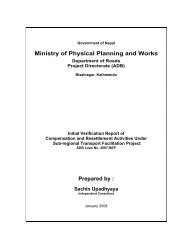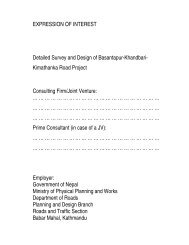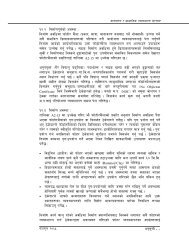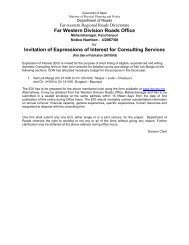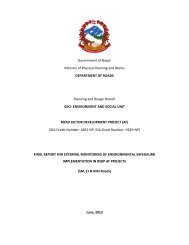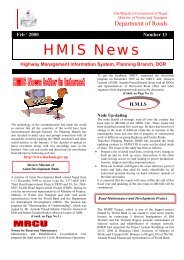Environmental & Social Management Framework - About ...
Environmental & Social Management Framework - About ...
Environmental & Social Management Framework - About ...
Create successful ePaper yourself
Turn your PDF publications into a flip-book with our unique Google optimized e-Paper software.
<strong>Environmental</strong> and <strong>Social</strong> <strong>Management</strong> <strong>Framework</strong>n. Hazards caused by Explosive, Combustible and Toxic MaterialsDuring road construction activities, explosive materials are needed to blast hardrocks to open road track. The use of explosives, if not done carefully, can lead toextensive environmental damages in terms of causing slope instability, excessiverock fracturing, damage to nearby property due to vibration as well as rocksplinters, injury, disturbance to wildlife, air pollution etc.The safeguarding of explosive from theft is also a major concern. The regulationsof the Government of Nepal for transporting both the gelatin and detonators arewell laid out and are carefully adhered to. A police guard and a responsible officerhave to accompany eachshipment. Problems more usuallyoccur with theft from stores inremote areas. In the past,explosives are thought to havebeen stolen for fishing or othercriminal activities. Recently it hasbecome a serious securityconcern.Contractors may store fuel, oil andlubricants, diesel and petrol,bitumen, solvents and other toxicchemicals for use in constructionwork. Inappropriate storage ofsuch materials or accidents oftankers may cause spillage orleakage, polluting surface and groundwater, contaminate soil, cause fire andexplosion hazards and nuisance to human health.Combustible materials mostly comprise fuels and lubricants, bitumen, and jutenetting. The most common risk involved is bitumen distributors catching fire.Cement, a widely used material but can cause minor chemical burns and skinproblems to the users. Protective clothing is rarely provided or used. In hotweather, it may be uncomfortable and therefore its use difficult to enforce.Explosives need particular handling and precautionary measures, both in termsof safety and in affecting the environment. Rock blasting may, for instance,trigger slope instability. Excessive rock fracturing is common feature in Kamphek-Rajarani and Chhinchu – Jajarkot roads. Minor widening of the Mugling –Marsyangdi section of Prithivi Highway led to a massive rock fall in November1994. This was cleared, but large falls continued at intervals in the same place.The slope was relatively stable before the widening was carried out, but itappears that the contractor’s use of explosives gave rise to a severe stabilityproblem.o. Potential impacts caused by BitumenThe use of bitumen is one of the most hazardous materials used for roadconstruction and maintenance activities. Bitumen storage is a frequentenvironmental problem that can only be met by special precautionary measures.Bitumen drums often get damaged during transit, leading to a leakage in storageplaces which often are not or not adequately cleaned up afterwards: Negativeexamples are plenty in Nepal, e. g. former storage area of Kurintar, where poolsof split bitumen can still be found in cattle grazing areas, many years after therehabilitation of the road was completed.During application, workers are often (for various but unacceptable reasons) notadequately protected. Bitumen is applied at a high temperature, leading to aApril 2007 Chapter 4-17



![j:6 ]zg cfof ]hgf](https://img.yumpu.com/51286794/1/190x245/j6-zg-cfof-hgf.jpg?quality=85)

![x'nfsL /fhdfu { cfof ]hgf](https://img.yumpu.com/50581959/1/190x245/xnfsl-fhdfu-cfof-hgf.jpg?quality=85)
